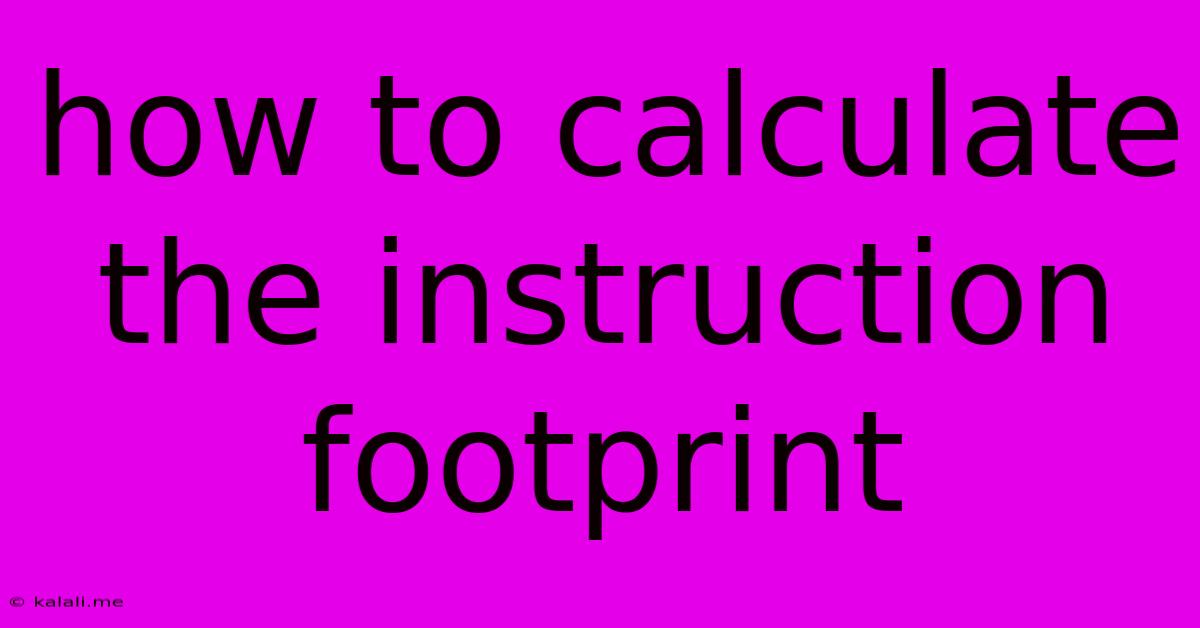How To Calculate The Instruction Footprint
Kalali
Jun 07, 2025 · 3 min read

Table of Contents
How to Calculate the Instruction Footprint: A Comprehensive Guide
Meta Description: Learn how to effectively calculate instruction footprint, a crucial metric for understanding program performance and resource utilization. This guide covers various methods and considerations for accurate measurement.
Understanding instruction footprint is crucial for optimizing program performance and resource utilization. It represents the total number of instructions executed by a program during its runtime. A smaller instruction footprint generally translates to faster execution and lower energy consumption. However, accurately calculating it can be more complex than simply counting instructions in the source code. This comprehensive guide explores different methods and factors to consider when determining instruction footprint.
What is Instruction Footprint?
The instruction footprint quantifies the number of instructions a program executes. This is distinct from the number of instructions in the source code because factors like compiler optimizations, branching, and looping significantly affect the actual number of instructions executed at runtime. A high instruction footprint might indicate areas for optimization, such as algorithm redesign or more efficient code implementation.
Methods for Calculating Instruction Footprint
There are several ways to determine a program's instruction footprint, each with its strengths and limitations:
1. Static Analysis:
This method involves analyzing the program's source code or assembly instructions without actually executing the program. While faster than dynamic analysis, it provides an estimate rather than a precise measurement. Compiler optimization passes can significantly alter the final instruction count, making static analysis less accurate.
- Pros: Simple and fast.
- Cons: Not entirely accurate due to compiler optimizations and runtime factors. The estimate might differ significantly from the actual runtime instruction count.
2. Dynamic Instrumentation:
This technique involves modifying the program to count instructions during execution. Tools like performance counters in processors or specialized software can be used. This yields a precise measurement of the instructions executed under specific runtime conditions.
- Pros: Provides accurate measurements reflecting real-world execution.
- Cons: More complex to implement; can introduce overhead that affects the program's performance. The measurement is specific to the particular execution scenario and input data.
3. Simulation:
Simulators can model the execution of a program at the instruction level, providing an accurate count. This offers a middle ground between static and dynamic analysis – avoiding the overhead of dynamic instrumentation while offering more precision than static analysis. However, choosing the right simulator and configuring it correctly is crucial.
4. Profiling Tools:
Many profiling tools offer information about the number of times different parts of the code are executed, which, when combined with static analysis, can provide a reasonable approximation of the instruction footprint. This approach is especially valuable for identifying performance bottlenecks.
Factors Affecting Instruction Footprint
Several factors significantly impact a program's instruction footprint:
- Compiler Optimizations: Compilers employ various optimizations (e.g., inlining, loop unrolling, dead code elimination) that dramatically reduce the number of instructions executed.
- Branching and Looping: Conditional statements and loops significantly influence the number of instructions executed. The path taken through the program's control flow drastically affects the instruction count.
- Hardware Architecture: The underlying processor architecture affects how instructions are fetched, decoded, and executed. Different architectures might have different instruction sets and execution models.
- Input Data: The input data to the program can affect the number of instructions executed, particularly in algorithms with data-dependent behavior.
Practical Considerations
When calculating instruction footprint, consider:
- Context: Specify the conditions under which the measurement is taken (e.g., input data size, hardware platform).
- Accuracy vs. Overhead: Choose the appropriate method balancing accuracy with the overhead introduced by the measurement technique. For quick estimates, static analysis might suffice; for precise measurements, dynamic instrumentation or simulation is preferred.
- Instrumentation Impact: Be mindful of how instrumentation can impact the program's behavior and the results.
Conclusion
Calculating instruction footprint is essential for performance tuning and resource optimization. The choice of method depends on the desired accuracy and the available resources. Understanding the various factors influencing the footprint allows for more informed optimization strategies. By systematically measuring and analyzing the instruction footprint, developers can improve the efficiency and performance of their programs.
Latest Posts
Latest Posts
-
12 Gauge Wire For Pool Pump
Jun 07, 2025
-
Ansible Core Requires A Minimum Of Python2
Jun 07, 2025
-
Can You Do Me A Solid
Jun 07, 2025
-
Fig Tree In The Bible Symbolism
Jun 07, 2025
-
Can You Stream Movies On Work Computer
Jun 07, 2025
Related Post
Thank you for visiting our website which covers about How To Calculate The Instruction Footprint . We hope the information provided has been useful to you. Feel free to contact us if you have any questions or need further assistance. See you next time and don't miss to bookmark.